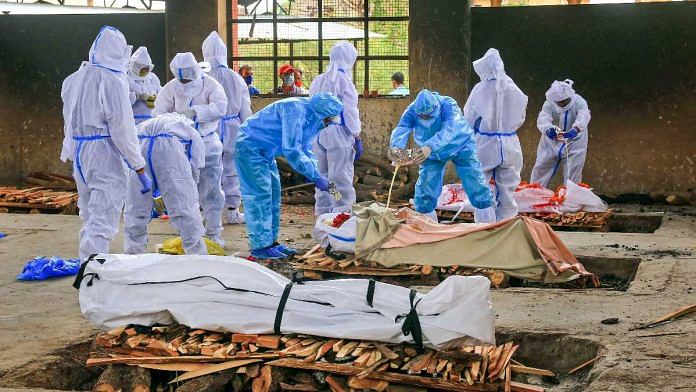New Delhi: India had over 8,30,000 excess Covid-related deaths in 2020 and 47,40,894 in 2021, according to the latest estimates published by the World Health Organization.
Immediately after the WHO released these estimates in a press conference Thursday, India’s Ministry of Health issued a rebuttal, objecting to the use of mathematical models for projecting excess mortality estimates, when it had made the data of excess deaths available earlier this week.
WHO’s new estimates show that the full death toll associated directly or indirectly with the Covid-19 pandemic across the world — described as “excess mortality” — between 1 January 2020 and 31 December 2021 was approximately 14.9 million (1.49 crore).
Excess mortality is calculated as the difference between the number of deaths that have occurred and the number that would be expected in the absence of the pandemic, based on data from earlier years.
Excess mortality includes deaths due to Covid-19, or due to the pandemic’s impact on health systems and society. Deaths linked indirectly to Covid-19 are attributable to other health conditions for which people were unable to access prevention and treatment because health systems were overburdened by the pandemic.
The estimated number of excess deaths can be influenced also by deaths averted during the pandemic due to lower risks of certain events, like motor-vehicle accidents or occupational injuries.
Also read: Indian govt ‘strongly contests’ WHO’s estimates of Covid deaths, questions its model
India’s objections to math modelling, WHO defends its data
For countries like India, WHO has used mathematical modelling to arrive at estimated figures. However, last month, the Narendra Modi government had raised strong objections regarding the methodology through a series of formal communications, including six letters to the WHO.
A statement issued on 16 April by the health ministry pointed out that the WHO used mortality figures directly obtained from its ‘Tier–I’ set of countries, but relied on mathematical modelling for ‘Tier-II’ countries (including India).
For its estimation, WHO had categorised countries as Tier-I or Tier-II based on the availability of “robust” deaths data. For Tier-II countries like India and Tunisia, whose mortality data sets were not complete, the WHO arrived at estimates using mathematical modelling, according to Somnath Chatterji, senior adviser, Department of Data and Analytics, WHO.
“The concern specifically includes on how the statistical model projects estimates for a country of the geographical size & population of India, and also fits in with other countries which have smaller population. Such one-size-fits-all approach and models which are true for smaller countries like Tunisia may not be applicable to India with a population of 1.3 billion,” the statement read.
Addressing this controversy, Samira Asma, Assistant Director-General for Data, Analytics and Delivery at WHO, said the agency engages in close consultations with the member states.
“These new estimates use the best available data and have been produced using a robust methodology and a completely transparent approach,” Asma said. “We are continuing to engage with colleagues in India.”
She added that India has now published its own CRS data, which the WHO will include in its next update of the excess Covid deaths, expected to be published in June.
While the WHO press conference releasing the figures was still underway, the Indian health ministry issued a statement, once again raising objections about the methodology.
Amid the tussle between WHO and India over the excess deaths data over the past year, the health ministry released India’s Civil Registration System data for 2020. The data showed a six per cent increase in the deaths in 2020 compared to 2019, and revealed the number of excess deaths in 2020 to be 4,74,806. Data for 2021 has not been released.
Details of WHO estimates
WHO’s estimates are a result of a global collaboration supported by the work of the Technical Advisory Group for Covid-19 Mortality Assessment, and country consultations.
This group, convened two years ago jointly by the WHO and the United Nations Department of Economic and Social Affairs (UN DESA), consists of many of the world’s leading experts, who developed an innovative methodology to generate comparable mortality estimates even where data is incomplete or unavailable.
As much as 84 per cent of the excess deaths are concentrated in South-East Asia, Europe, and the Americas.
Some 68 per cent of excess deaths are concentrated in just 10 countries globally.
Middle-income countries account for 81 per cent of the 14.9 million excess deaths — 53 per cent in lower-middle-income countries and 28 per cent in upper-middle-income countries. High-income and low-income countries each accounted for 15 per cent and 4 per cent respectively.
The estimates confirm that the global death toll was higher for men than for women, and higher among older adults. The absolute count of the excess deaths is affected by the population size.
WHO has published the input data, the methods, and codes for the models for countries to verify.
(Edited by Shreyas Sharma)
Also read: WHO adds Pfizer’s 2-drug antiviral Paxlovid to Covid recommendations for high-risk patients



